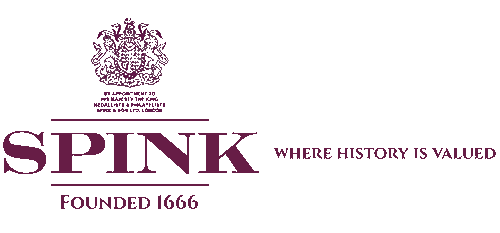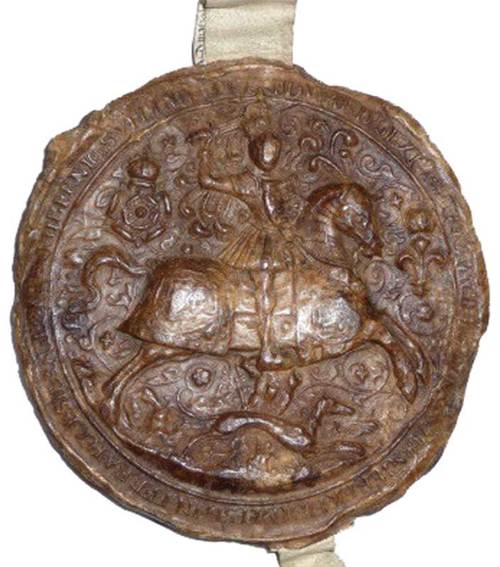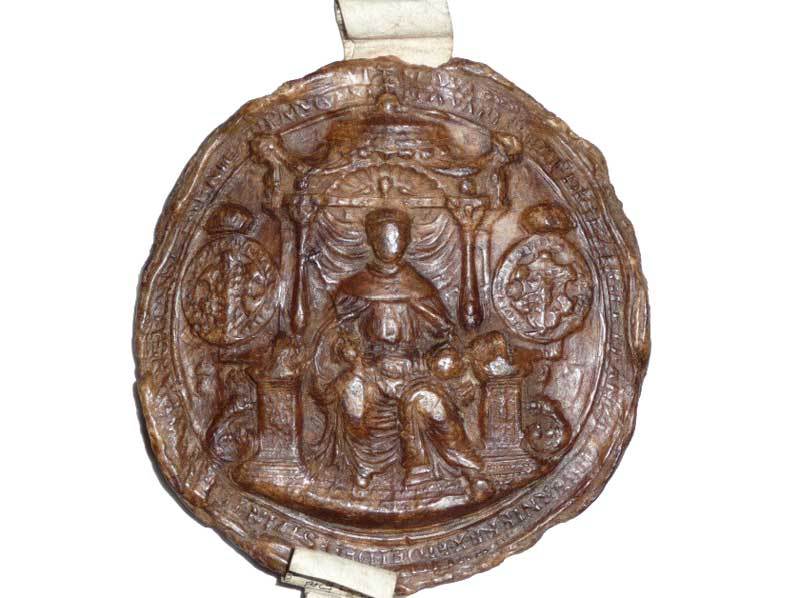Auction: 15037 - Autographs, Historical Documents, Ephemera and Postal History
Lot: 3
Documents
Letters Patent Granged by King Edward VI
1552 (6 October) on one skin of vellum and written in an attractive official hand.
A licence for 42s. 2½d. paid in the Hanaper to lady Elizabeth Fane (widow) to grant her tithes of grain and hay and other tithes within the ward of Hilden, commonly called Hilden Warde, within the parish of Tunbrydge (Tunbridge), Kent, late parcel of Tunbrydge rectory to Humphrey Dixson and John Dixson and their heirs and assigns of the said John. Witnessed at Westminster the 27th day of October 6.
On the fold of this patent the costs are broken down as follows: 13s. 2½d for a fine or the tax, 20s. 4d for the seal, 4s. for the enrollment and further entries.
The document bears the Great Seal of Edward VI which is in remarkably fine condition, clearly showing all of the lettering and the fine detail of the seal. A couple of minor edge knocks do not detract from this magnificent seal.
This is the second seal of Edward VI used between 1548 and 1553. It shows the king enthroned, royal robes, tippet, crown, royal sceptre and orb, on carved throne, with shell shaped back, on which the initials E. R. beside king’s head with cherub’s head and wings above them, and circular baldachin having curtains at sides looped up in a large bunch, scroll work at sides (panels with trophies), carved footboard, on the arm piece on each side a lion. In the field on each side an ornamental shields of arms of France and England quarterly, encircled with garter inscribed with the motto and ensigned with the crown royal.
EDWARDI SEXTI DEI GRATIA ANGLIE FRANCIE / ET HIBERNIE REX FIDEI DEFE[N]SOR ET IN
TERRA ECCLESIE ANGLICANE ET HIBERNICE SVPREMVM CAPVT (Edward the Sixth, by the grace of God of England, France / and of Ireland King, Defender of the Faith, and on Earth, of the English and Irish Church, Supreme Head).
The reverse is the King on a horse, plumed and crested helmet, shield of arms as before, sword held over head, horse trapping richly flowered, and having two shields of arms as before, one shoulder and one on thigh; greyhound running beside horse in foreground, between two lopped trees, Background ornamented with scrolls of foliage, four small fleur-de-lis, three cinquefoil roses, large rose ensigned with crown over tail of horse, and fleur-de-lis similarly ensigned, in front of horses head.
An important Letter Patent and a valuable item of Kent history. Photo
Hilden is a manor situated at about a mile's distance from Tunbridge town, and was antiently part of the possessions of the family of Vane, written a-Vane in antient deeds, before the reign of king Edward III. one of them, John Vane, esq. had two sons of the name of Henry; the eldest of which left an only daughter and heir, married to Sir Peter Blondevil; the youngest Henry Vane, was of this place, esq. and had three sons; John Vane, esq. of Hilden, and afterwards of Tudeley, ancestor of the several branches of this family since enabled; Thomas, whose son Humphry died without issue; and Henry, who was father of Sir Ralph Fane, attainted in the reign of king Edward VI.
By his will in the 34th year of King Henry VI. he devised this manor to his eldest son John, and the parsonage of Hilden to his youngest son Henry. John Vane, esq. sold the manor in the 10th year of King Henry VII. to Tattersal, one of whose descendants possessed it at his death in the 6th year of King Edward VI. anno 1551, when it was sound that he died possessed of this manor, and five hundred acres of land, in Hilden and I unbridge, held of the honor of Tunbridge, by knight's service, and that John Tattersal was his son and heir. He alienated it to Humphry Dixon, who in that reign had purchased the parsonage of Hilden of Elizabeth, Lady Vane. He was the second son of Thomas Dixon, esq. of North-frith, in this parish, descended of a family of good account of this name in Scotland, who bore for their arms, or, a cross formee or palee throughout the shield, gules, between four eagles displayed, sable.
John, the eldest, succeeded him in this manor, and resided here, he left two sons; Henry, who was of Hilden, esq. and justice of the peace; and William, who was of Darent, in this county. Henry Dixon, esq. the eldest son of Humphry, resided here, as did his grandson of the same name, who died in 1669, leaving two daughters his coheirs, who possessed this manor in undivided moieties. Jane, the eldest, married Nathaniel Booth, esq. and Sarah, the youngest, Percival Hart, esq. of Lullingstone.
Percival Hart, esq. died in 1738, leaving an only daughter and heir Anne, then married to Sir Thomas Dyke, bart. of Horeham, in Suffex, who became possessed of one undivided moiety of this manor, as he did likewise of the other moiety on the death of Mrs. Jane Booth, widow, above mentioned, without issue, in 1743. Sir Thomas Dyke died in 1756, leaving his widow surviving, who possessed the whole of this manor till her death in 1763, when it descended to their only son and heir Sir John Dixon Dyke, bart. of Lullingstone, who procuring the authority of parliament, sold it, in 1767, to Thomas Harvey, esq. of Tunbridge, the son of Thomas Harvey, of Deal, descended of the family of Harvey, settled so early as King Edward the IV's reign, at Tilmanstone, in East Kent, and afterwards dispersed over the several parishes in that neighbourhood, in the description of which parish a full account of them may be seen, whose arms being, Argent, on a chevron gules, three crescents or, between three lions gambs erased, sable, are likewife borne by this branch of it. Mr. Harvey, of Tunbridge, married Charlotte, youngest daughter of the Rev. William Davis, vicar of this parish, by whom he had two sons, Thomas, now of Redleaf, in holy orders, and William Thomas; and three daughters, Charlotte, Sophia, and Frances. He died in 1779, leaving his widow Mrs. Harvey, surviving, who is by his will possessor of this estate for her life, after which it will devolve, by his devise, to this eldest son, the Rev. Thomas Harvey.
At a small distance from Hilden-green, stood the manor-house, the ruins of which were entirely erased some years ago, by Sir Thomas Dyke.
A court baron is held for this manor.
From The History and Topographical Survey of the County of Kent: Volume 5. Originally published by W Bristow, Canterbury, 1798.
Subject to 20% VAT on Buyer’s Premium. For more information please view Terms and Conditions for Buyers.
Estimate
£1,500 to £1,800







